A little while ago I did a
post meant as an introduction to my love of tartan. Originally that plaid obsession was
supposed to stay in the 1860s, where Queen Victoria put it (a post on that later!), but it has bled into just about every period I do. Oops.
As lately I've been all about building a Regency wardrobe, it shouldn't come as a surprise that I jumped at the chance to make Regency tartan. In particular, I am in love with these two fashion plates:
 |
| Feb. 1801 |
 |
| Paris fashions after Waterloo, 1815. Please excuse the blur--I scanned this from the book The Costume of Scotland, by John Dunbar |
They are both of a similar style, although from 14 years apart: the actual plaid part is an overdress with no sleeves and a "v" neckline. Overall I like the second plate better (and it's within my target range of 1810-1815 for Regency sewing), because I am fond of chemisettes, but the hat from the first image really does it for me. If I end up buying a light wool plaid to make something like this, I will aim for enough fabric for an overdress and hat, which I can then mix and match.
But was tartan really popular during the 18-teens? or are these images unique?
As I discussed
here and
here, the wearing of
Highland dress was banned after the Jacobite uprising (the Act of Proscription, 1747, can be read in full
here). The act was officially repealed in 1782, but for at least two or three decades before that the enforcement of the law had dropped off. In fact, even before the repeal the Highland Society of London was founded in 1778, which strove to preserve the art of tartan weaving as well as preserve the already dwindling Gaelic language and culture of the Scottish highlands. The society also maintained a philanthropic branch which aided expatriots and worked to promote economic and agricultural growth in the highlands. The society was instrumental in the repeal of the Dress Act, and was the first group to collect tartan patterns specifically from the clans, which they kept in The Collection of Certified Tartans--the beginnings of the modern governmental board.
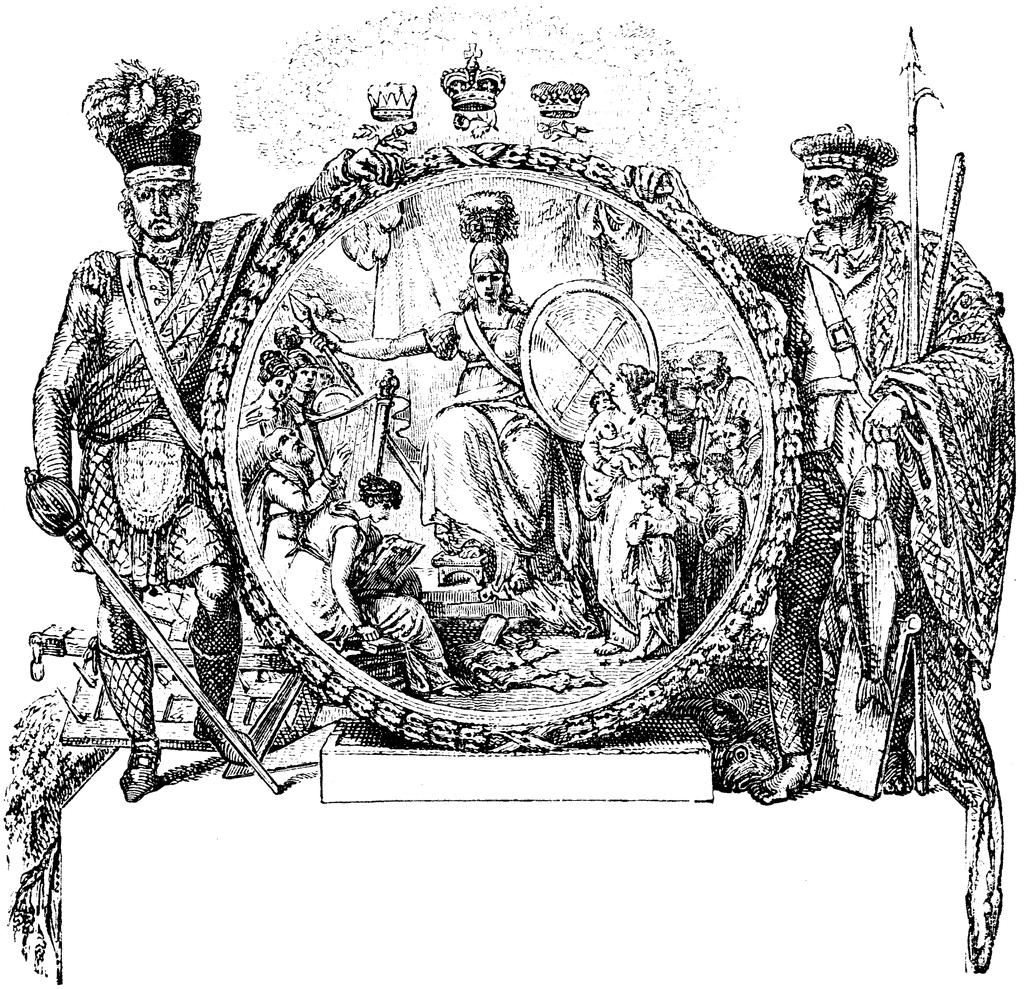 |
| Diploma of the Highland Society of London, designed by Benjamin West 1805 |
In the 1750s tartan was also re-adopted into military uniforms. The Scottish Highlands were a popular area for recruitment during the earlier Seven Years' War as a way of combating remaining negative feelings towards the British crown and because Highland men were tough. As a way to encourage recruitment, these regiments wore a militarized version of highland dress (allowed by the Act of Proscription due to an exception for military use).
During the Napoleonic Wars in the early 19th century, these Highland regiments played a large role and were well-known by their tartan uniforms, which had developed into a standardized set by 1812.
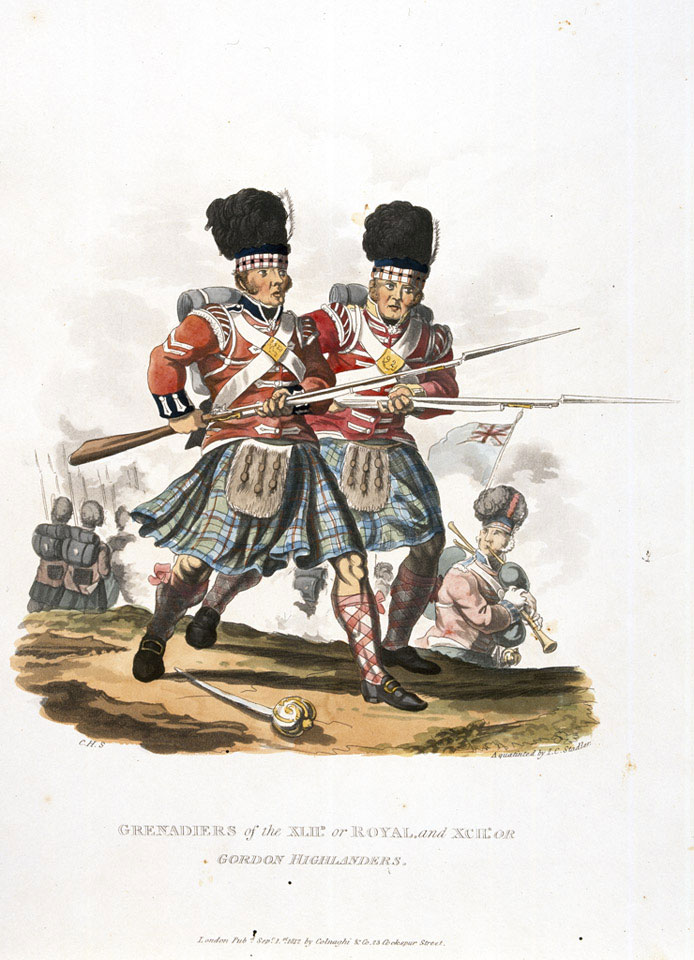 |
| Illustration of Grenadiers from the 42nd and 92nd Highlanders during Waterloo, 1812 |
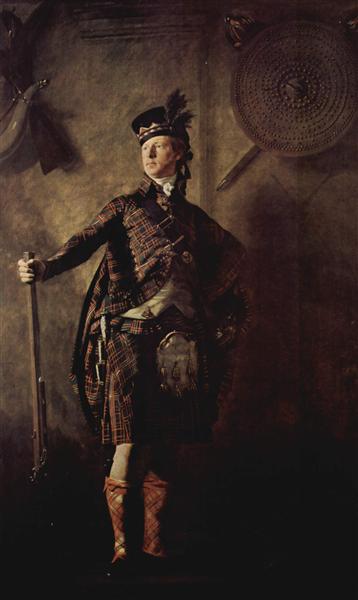 |
| "Mac Mhic Alasdair," by Henry Raeburn, 1812. Portrait of Colonel Alasdair MacDonnell of Glengarry, wearing a fabulous ensemble meant to show his heritage as leader of Gaelic society |
These uniforms were similar to more traditional British military dress in that the color of facings and jacket details varied based on the regiment. The standardized kilt was of the "'Government Pattern,' a dark tartan of green, blue, and black in which distinguishing lines of red, white and yellow were added for different regiments" (
Tartan by Hugh Cheape, p44). This tartan was adopted into women's fashion during the period as well; wearing military-inspired items was a common occurrence during the regency, and there are many other examples of this besides the wearing of tartan.
 |
| a cartoon portrait by John Kay, in which the ladies are wearing feminized versions of the West Lowland Fencibles uniform, 1795 (courtesy of the British Museum) |
While there are several tartans in the modern Register of Tartans dated to this period, they share some traits: they tend to be dark-colored, with mostly blue and green--similar to the tartans in standard military dress for the Highland regiments.
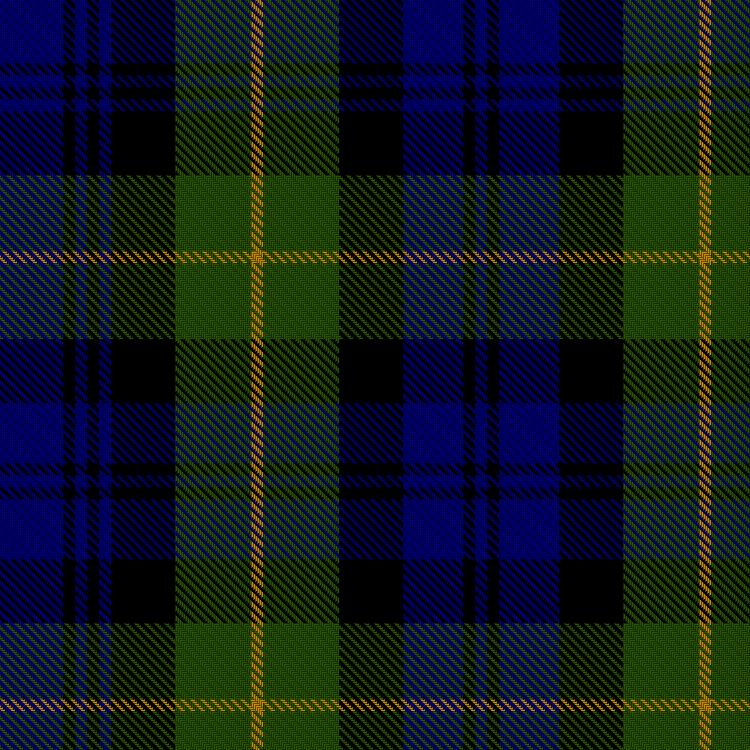 |
| Registered tartan of the 92nd (Gordon Highlanders) Regiment, as recorded 1819 |
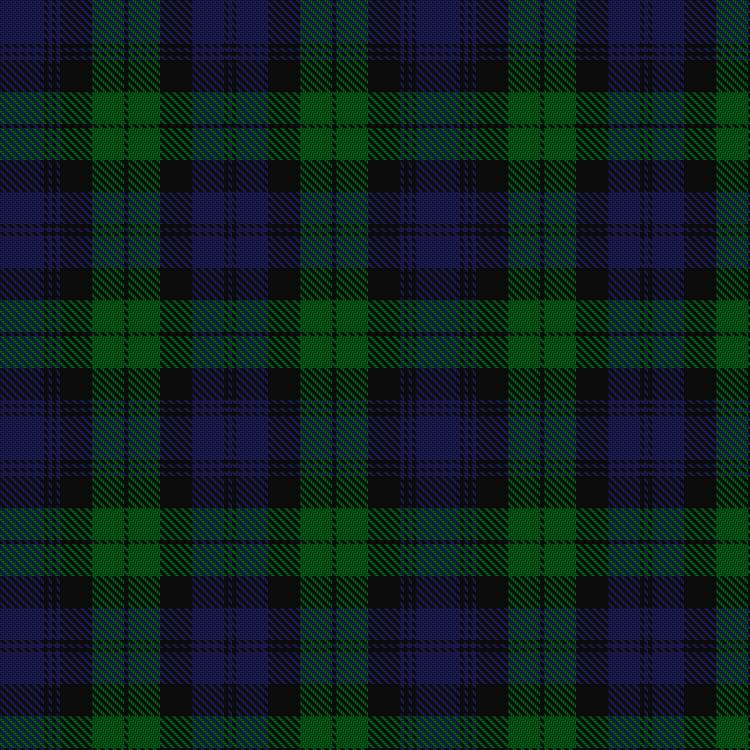 |
| Black Watch tartan, originally dated 1725 |
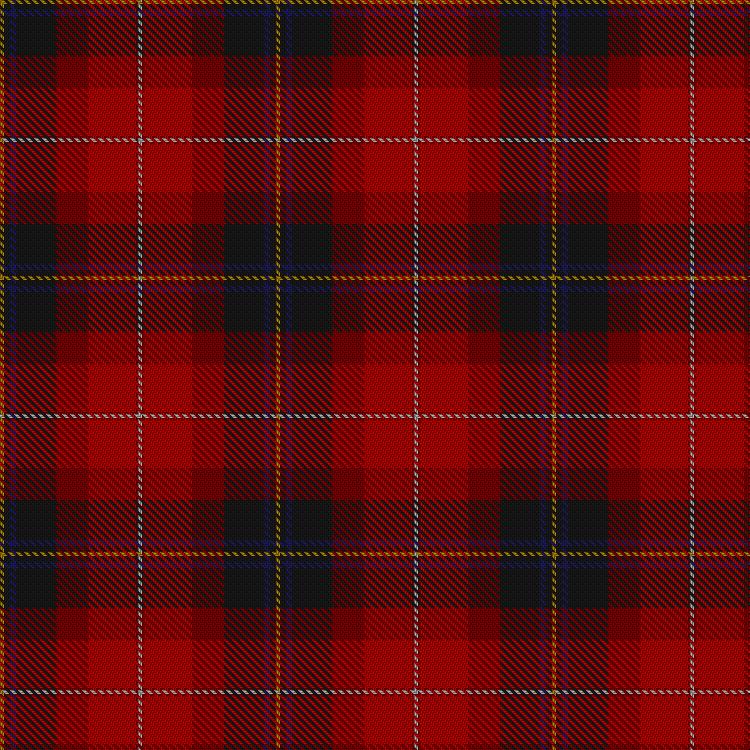 |
| Sir Etienne Tache, date unkown. Noted that the owner fought in the War of 1812 |
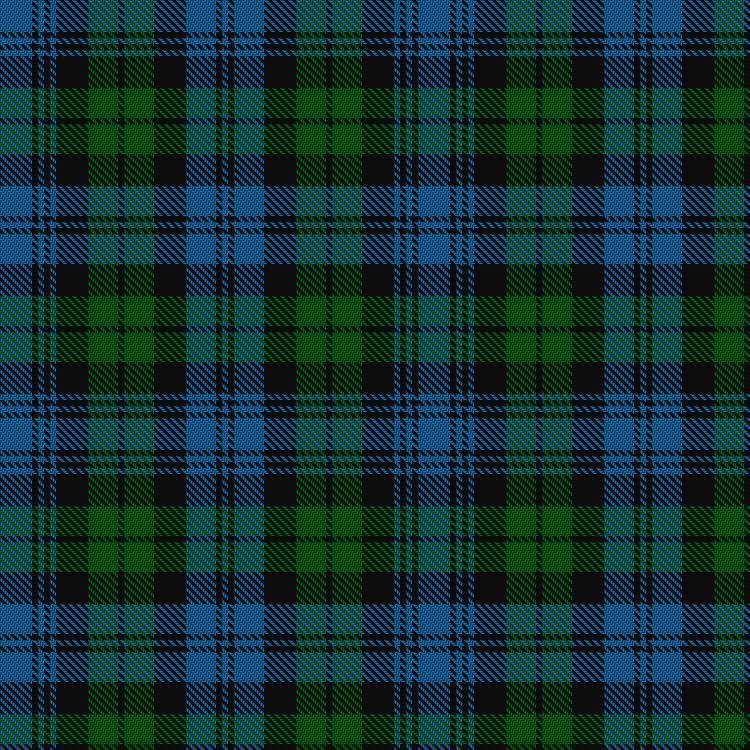 |
| tartan of the 42nd Highlanders, dated 1797 |
This is just an assortment of the ones I like--you can find all of them in the
Register of Tartans, and several more of my selections on my
Pinterest board.
But did women really wear tartan? We know from the 1801 fashion plate that plaid was present to some degree in women's fashion, and certainly tartan was quite popular by 1815.
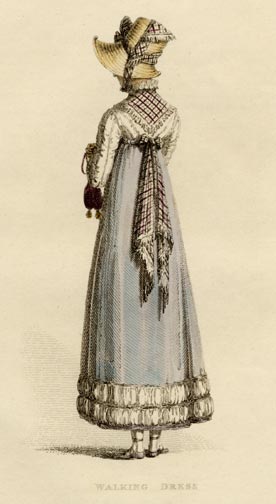 |
| fashion plate 1814, plaid shawl and plaid ribbon-trimmed bonnet |
 |
| tartan-themed opera dress (and hat!) in Ackerman's Repository, 1814 |
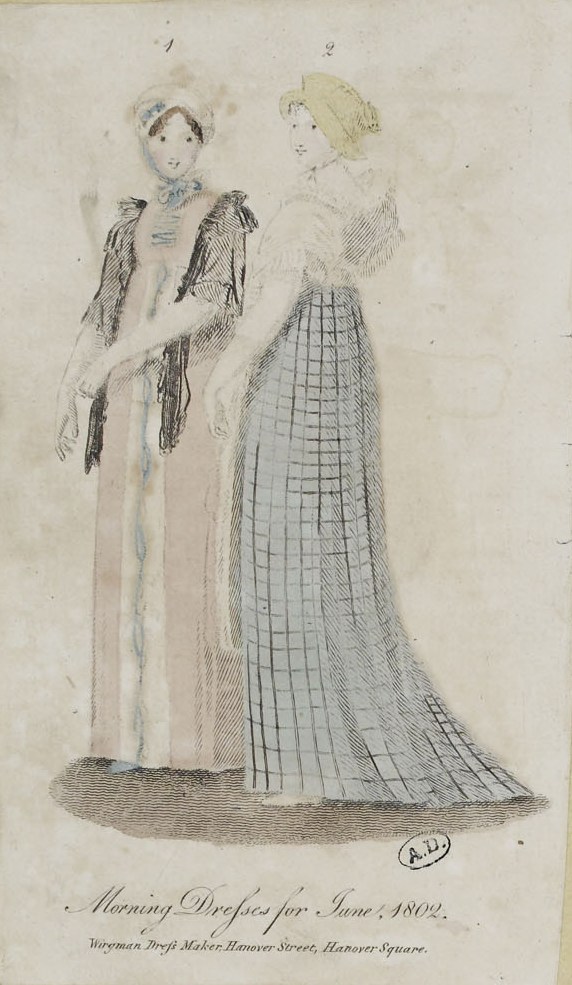 |
| Day dresses for June, 1802. The one on the right is plaid! |
 |
| "Portrait of a Lady, Half-Length, in a Plumed Dress and a Tartan Shawl" by Sir Henry Raeburn, c. 1756-1823 |
 |
| tartan walking dress, 1811 |
So the final verdict? Yes, women wore plaid--and even tartan--in the 18-teens. There are enough examples (not all of which are collected here, obviously) to justify a tartan ensemble,
especially if you are British, or hanging out with a British reenacting regiment at your next 1812 event. Too bad all the guys I know are going American with their uniforms...boo.
For those on the other side? A tartan ribbon at the waist, on a hat (or a tartan bonnet!), or a piece of outerwear (shawl, spencer) are perfectly acceptable.
I will certainly be keeping an eye out for navy blue/hunter green-based tartans at the fabric store...
Sources!
Scottish Register of Tartans (see the link above)
Costume of Scotland, by John Dunbar (1981)
Tartan, by Hugh Cheape (1995)
The National Museum of Scotland
The British Museum












Thank you very much for this. I want to make a passing comment about a Scots merchant trying a speculative trip to France with plaid cloth around Christmas 1814, when everyone still thinks that Napoleon is going to sit on Elba like a good boy; I think there's enough justification for an ambitious man to see if the market is there.
ReplyDeleteThis comment has been removed by the author.
DeleteI think that's plausible :) I'm glad this was helpful for your writing!
Delete... I should have mentioned that this is in the WIP
ReplyDeletethank you! weep for the plaid cargo though, it's going to the bottom in the hurricane of December 1814
ReplyDelete